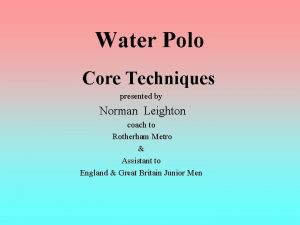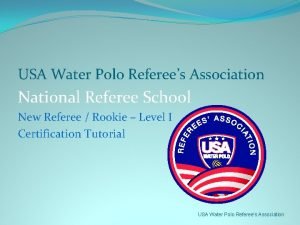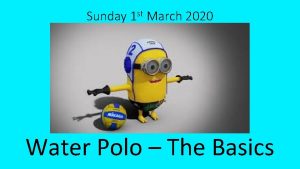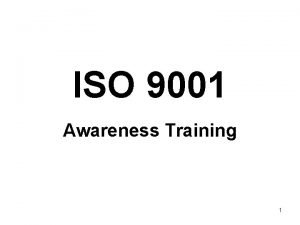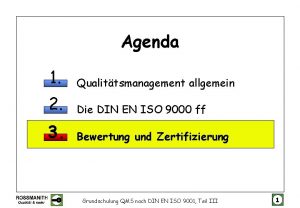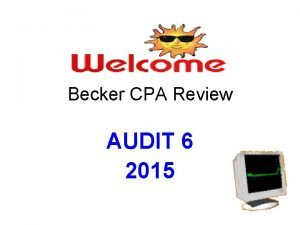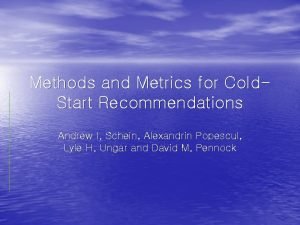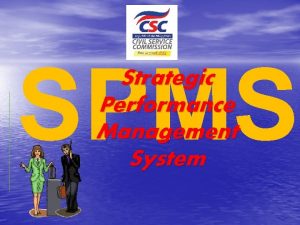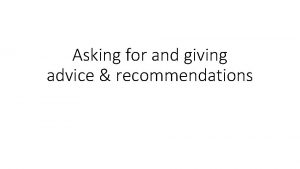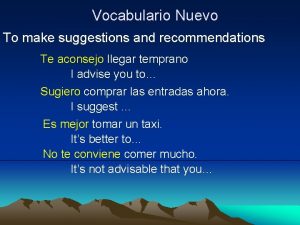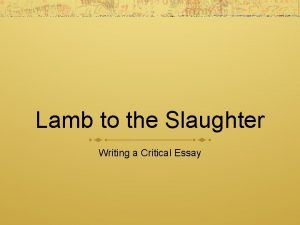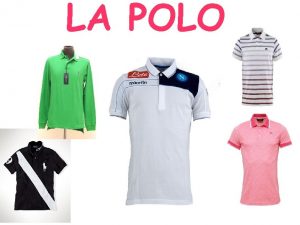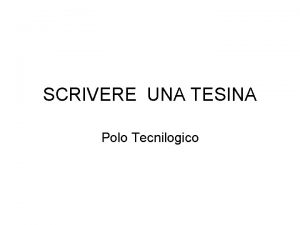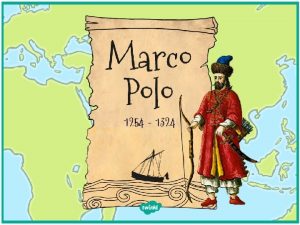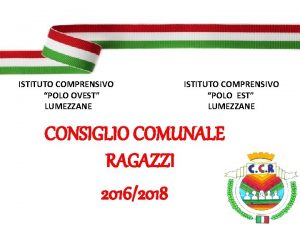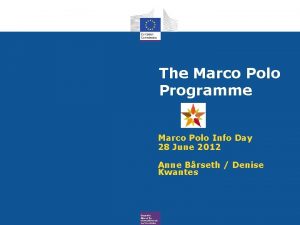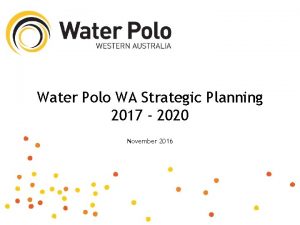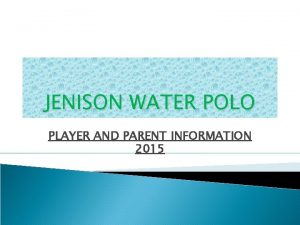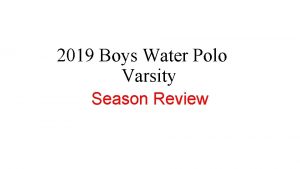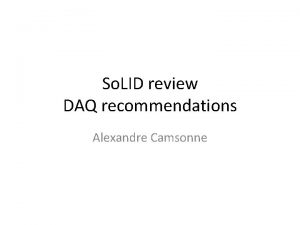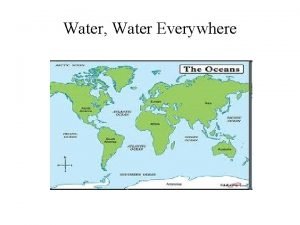Strategic Review and Recommendations for Water Polo 2015






















- Slides: 22

Strategic Review and Recommendations for Water Polo 2015 – 2024 January 2015

Project methodology • Desk research: • • • ASA & BS structure & strategy Membership & club statistics Performance standards & results Competitions structure Workforce development programmes: • Other sports as a comparator • Previous water polo reviews • Regional development plans • Various websites – national / regional / local • One-to-one interviews: • 38 F 2 F / Skype / telcons • Two written submissions • Online survey: • 726 respondents = >10% of estimated total constituency • 53% current players, 32% coaches, 27% parents, 15% referees, 16% table officials • Distribution across England reflects water polo map: • 10% SCO / WAL • 76% current ASA members • 52% water polo only, no other aquatic involvement • 73% involved for >5 years • 45% aged >40 years

SWOT analysis Strengths / Opportunities Weaknesses / Threats • Numbers of dedicated and able volunteers • Regional partnerships and pockets of good practice (North-West, London) • Beacon clubs, and others, trialling recruitment and development • National competitive framework and organisational capacity of the BWPL • Strong presence in independent schools • Number of universities playing WP • Efficiencies within training and competition • Increased awareness from 2012 of the requirements of high performance • Pay-to-play culture within the sport • Available pockets of resource on a local / regional basis • • • Lack of leadership – vision / plan / co-ordination No co-ordination of existing resource Lack of pool-time / swimming as an inhibitor No clear pathway into / through the sport Club culture: threat of emerging learned helplessness / absence of a training culture Talent pathway favours the most available, not the most able Lack of an elite domestic competition as a focal point “ 2012 -itis” Coaching: high cost of CEP / no Level 3 / poor technical coaching in clubs Ageing / declining officials workforce

Areas for attention • Leadership, governance & management • Performance • Talent pathway • Competitions development • Participation & club development • Workforce development • Marcomms • Finance and resource

Leadership, governance and management Water Polo Management Group Governance & audit Participation & clubs Performance pathway • Need to rebuild trust … and unification • WPMG a portfolio- / competence-based group: • Sub-group chairs comprise the WPMG • Open and transparent recruitment against clear role descriptions, based on demonstrable capability to fulfil the role • Independent Chair and Manager: Competitions & events Workforce development Marcomms & commercial Sub-committees operated by sub-groups as required, e. g. , coaching, match officials by Workforce Development • Chair is titular head – sits on ASA SGB …? • Independence to retain an external view • Clear To. R, including agreed responsibilities and powers: • WPMG needs the requisite powers to fulfil its duties • Critically important to predetermine areas of control / delegated authority – e. g. , fund-raising, budgets, staff management & deployment

Leadership, governance and management • Regional forum – periodic gathering of 8 x WP committee chairs / managers to share information / expertise • Annual WP conference – for WPMG to report on delivery of strategy, and demonstrate accountability to the sport • GBR strategy / management group comprising: • WPMG Chair and Performance Pathway rep • SCO & WAL representatives • Determines all matters relating to GBR teams, clubs and officials, in international competition • Requires clearly and properly delegated authority from BS to do this • Longer-term cost-benefit analysis / feasibility study regarding an independent NGB for WP: • WP is an uncomfortable fit within a swimming NGB: • “Black sheep of the family” • Team sport vs individual sport • Swimming a rival for pool-time / inhibitor to growth • Precedent within other, successful WP nations: • BUL, CZE, HUN, ROM, SLO, SRB, SVK, TUR • Acknowledge that WP may not currently be in the place to pursue UDI – but there is undoubted value in exploring the potential, the steps required, and the profit / loss to be generated: • Even if the answer is no … • Opportunity to review issues of ASA membership around, inter alia, schools and universities

Performance • Online survey showed the strong desire of the WP constituency for a meaningful GBR international programme; also need for an aspirational tier at the top of the domestic / talent pathways • Beware “ 2012 -itis”: • London OG / WCP was a spike, and not the normal trend – unique circumstances, not repeatable in the short- to medium-term • Rio 2016 OQS: • GBR men and women needed to win EC / top three in OQT • EC track record and current WR suggests that this is highly unlikely: • Men at best 12 th in EUR • Women at best 7 th in EUR • Agree that there was no value in pursuing OG qualification • Propose that GBR steps out of senior EC for an initial period of two years, in order to improve performance underpinning: • Progressive pathway • Training culture • Regular, intense domestic competition • Plan short-term, senior-level future as ENG: • Summer-based international programme on selffunded basis, as progression from Talent pathway • Align with home nation programmes, i. e. , 4/5 Nations, 8 Nations • Continue to pursue Commonwealth Championships • Ten-year programme to construct performance underpinning: • Progressive pathway; training culture; regular, intense domestic competition • Review points along the way, as to when circumstances allow return to EC qualification • Long-term aim to qualify team(s) for 2024 Olympic Games

Performance underpinning: talent pathway • Revision required as part of a wider vision to improve performance underpinning: • Progressive pathway • Training culture • Regular, intense domestic competition • Currently efficient, but not effective: • Favours those most able to pay • Focused on tournament teams, not pathway players • No clear athlete profile • No tangible outcomes at international level • Clear purpose and structure for the pathway: • Support GBR outcomes at senior level • LTAD framework as the basis • Learning to Train at U 14: • Weekly training at 20 x RTCs at Years 7 -8 / age 11 -13 – with dry-side S&C outline • Competitive outlet: inter-counties → interregionals at U 14 • Training to Train at U 16: • Regional, not GBR / ENG – up to 8 x regional programmes at Years 9 -11 / ages 13 -16 • Up to 8 x Regional Performance Centres with nationally appointed and supported Regional Coaches: • Potentially clubs / schools / universities / facilities • Bristol & Manchester already in place through Beacon programme • 11 x monthly training sessions p. a. as a minimum – as often as is practicable • Focus on individual skills development, and dry-side generic SSSM education (S&C, nutrition, injury prevention, basic psychology) • Competitive outlet: inter-counties → inter-regional competition → international competition • M&E / QA nationally around coaching standards • (RTCs function at two levels: • Years 7 -8, for skills acquisition and development under coaches prior to identification / selection into regional programmes • Years 9 -11, for (a) regionally identified talent to access pool-time under coaches; and (b) potential late developers to train on)

Performance underpinning: talent pathway • Training to Compete at U 19: • National programme at Years 11 -13 / ages 16 -19 • National Coaches, one per gender, with technical responsibility for athlete profile, all national teams’ style of play, etc. : National, 16 -19: Training to Compete National Men’s / Women’s Coach • Also position-specific coaching consultants • 11 x monthly training sessions p. a. as a minimum – as often as is practicable • Individual development plans for all nationally identified players • Competitive outlet = GBR U 17 and U 19 teams in EC / ESSA U 18 team: Regional, 13 -16: Training to Train Up to 8 x RPCs 8 x Regional Coaches • Shared cost / programmes with SCO / WAL for GBR? • Clear exit routes into (a) elite domestic competition, and / or (b) university hub … aiming to peak at age 25 • (Possibility to align TASS / AASE programmes within college(s) to support this stage) • (Longer-term possibility of U 18 competition within elite domestic competition? ) Local / regional, 11 -13: Learning to Train 20 x RTCs <20 x RTC Coaches

Performance underpinning: training culture • Take time to build an improved training culture and environment in clubs / facilities (Training to Win): • Currently training ~4 -6 hrs p. w. vs EUR teams 2 -3 hrs p. d. • At top end, suggest 4 x ball sessions, 4 x swimming sessions, 3 x gym sessions = 16 -24 hrs p. w. : • Cascaded through the age grades, so that constant build-up from youngest ages • Supported by athlete, parent and coach education • Acknowledge that available pool-time is an inhibitor – but what is the alternative? • Need to identify clubs / centres / facilities where targets are deliverable • Value in university programmes, utilising scholarships / shared value in elite programmes

Performance underpinning: training culture Age School Year LTAD stage Under 9 3 -4 Fun-based introduction 9 -11 5 -6 FUNdamental 11 -14 14 -16 16 -19 7 -9 9 -11 11 -13 / FE 19 -23 13 / FE / HE 23+ HE / employment Training requirement Hrs p. w. • 1 -2 hrs p. w. – learning to swim / fun-based play 1 -2 • 1 -2 hrs p. w. learning to swim • 1 -2 hrs p. w. Mini Polo play 2 -4 Learning to Train • 4 -5 hrs p. w. core skills training / Cadet Polo play • 2 -3 hrs p. w. swim fitness • 1 -2 hrs p. w. dry-side S&C 7 -10 Training to Train • 6 -7 hrs p. w. core skills / team training / match-play • 2 -3 hrs p. w. swim fitness • 1 -2 hrs p. w. dry-side S&C 9 -12 Training to Compete • 8 -9 hrs p. w. core skills / team training / match-play • 2 -3 hrs p. w. swim fitness • 2 -4 hrs p. w. dry-side S&C 12 -16 Training to Win • 8 -9 hrs p. w. core skills / team training / match-play • 4 -9 hrs p. w. swim fitness • 4 -6 hrs p. w. dry-side S&C 16 -24

Performance underpinning: competitions development • Felt needs include a structured season, Sept – May, with and agreed hierarchy of competitions: • Key role of Competitions & Events Subgroup to deliver this • Regular, intense, top-level domestic competition underpinning performance (Training to Win): • Best against the best, week in, week out • Uncertainty of outcome, “to-the-wire” matches • Minimise the distance between domestic and international sport • (Creates commercial properties / spectator potential / revenue generation / increased awareness) • Junior & youth competition programme which: • Increases amount of quality match-play available to young players, for purposes of retention and development • Is aligned with athlete development pathway / periodised in support of outcomes • Addresses current imbalance between domestic and representative WP • Consolidates activity across schools and club sectors • Is sympathetic with players’ academic commitments • Development of match officials to support the calendar: • See below on shortage of match officials – “no ref, no game”

Competition formats Athletes’ needs The format Coaches’ needs Competition

Competition pathway School Year Competition Focus Under 9 3 -4 Fun-based introduction 9 -11 5 -6 FUNdamental • Intra-school / club competition • Local inter-school / club competition Mini Polo Learning to Train • Local inter-school / club competition • ESSA U 13 competition • Inter-counties → U 14 inter-regionals Cadet Polo Training to Train • Local inter-school / club competition • U 15 National Age Group Championships / ESSA U 15 competition • Inter-counties → U 16 inter-regionals 11 -14 14 -16 16 -19 19 -23 23+ 7 -9 9 -11 11 -13 / FE Training to Compete Current competitive outlet • Intra-school / club competition • • • Local inter-school / club competition U 17 National Age Group Championships ESSA U 18 competition / Do. C Cup Inter-counties → U 18 inter-regionals U 19 National Age Group Championships 13 / FE / HE (a) Training to Win (b) Social & recreational • BUCS / Upolo university competition • Open-age club leagues: • BWPL / British Championships • Regional & county leagues HE / employment (a) Training to Win (b) Social & recreational (c) Returners and Masters • BWPL / British Championships • Regional & county leagues Recommended game format UKSG Aquasplash Footy Full Water Polo Requires revision / consolidation so that FFP against desired outcomes Age

Performance underpinning: competitions development Elite League / BWPL Premiership Eight-team competition, season-long, H / A Promotion subject to fulfilment of minimum standards BWPL Regional 1 BWPL Regional 2 BWPL Regional 1 Central-venue matches Play-offs involving crossover matches BWPL Regional 1 Regional Leagues (as current) Local Leagues (as current) Player registration permits athlete involvement at different levels • Changes in train within British Championships are a step along the road towards greater intensity within the domestic season: • Further progression required to deliver a compelling performance / commercial offer • Medium-term vision to have a minimum standards-based elite league at the head of the BWPL comprising the best-appointed clubs / centres competing in top-level facilities on a season-long basis: • Minimum facility requirements, including dryside access to S&C • Pool time to allow 6 -9 hours ball work p. w. , and 6 -9 hours lane swimming • Quality-assured coaching structures • Junior & youth development programmes / links • Senior men’s and women’s teams • Open opportunity for other clubs to aspire to this level, if they qualify for promotion and can fulfil minimum standards requirements: • Diminished standards at different levels, to help build towards elite …?

Regional hub sites Where? Full-size Olympic pools in: • Bristol • Leeds • London • Manchester • Plymouth • Sheffield • Sunderland 50 m university pools in: • Bath • Guildford • Loughborough • Norwich • Birmingham (planned) 14 x other 50 m pools including: • Aldershot • Corby • Liverpool • London boroughs • Nottingham (planned) • Portsmouth Olympic pool Junior / youth programmes Dry-side S&C Up to 8 regional hubs Competitive outlets: club, region Access to SSSM Facility access Quality coaching input One of these identified as a national centre?

Participation and club development • Estimated 7000 active WP players: • Structured recruitment through quality programmes: • Lots of “pub teams” – fewer “clubs”: • Recruitment / retention requires a quality experience in clubs: • Registration imprecise, needs better data • 7. 5% of ASA Category 2 membership • Cf. lacrosse (16, 000), baseball / softball (21, 000), volleyball (42, 000) • Club = multiple teams, pyramid structure, training culture, etc. • Flawed assumption that LTS will produce more players – need agreed, progressive introduction via small-sided games Mini Polo (no rules) Cadet Polo (modified rules) FUNdamental / Learning to Train • • • Coaching Training into appropriate competition Pool-time Facilities Safe and well-managed • Emerging Beacon club model for an agreed hub-club framework: Proposed age-and-stage pathway: UKSG Aquasplash Footy • Coaching in schools / Sportivate • Swimming pool / leisure centre programmes • Strong and clear links into quality clubs Full WP • • • School-club links University-club links Hub-satellite links Level separation between hub and satellites Need for clarification and communication of this model, to address current fears within the sport

Workforce development Coaching Match officials • Quality and quantity key to all of the above – critical priority area • Ageing population, declining numbers, places intolerable burden on handful of individuals: • Pre-Level 1 course(s) – “Ready to Coach”: • Comprising generic elements of current Level 1 • Amend Level 1 to include additional technical content • Review Level 2 in light of the above • Finalise and propagate Level 3 • Develop WP-specific CPD modules for L 1 -2, with online resources • Address cost of CEP: FA RFU RFL EN Io. S / WP Level 1 100 -175 100 140 150 192 -370 Level 2 100 -175 138 200 360 620 -650 Level 3 450 750 850 1200 ? ? ? • 6 -12 top-end officials, majority at D Grade, few in the middle – hiatus in the pipeline • Why so few? High demands, low job satisfaction: • Including through player abuse / inappropriate disciplinary framework • Urgent action required, including: Pathway review under way, requires support Promotional initiative to drive recruitment Introduce “Junior Whistler” award, or equivalent Finalise table officials award under development Clean database of current, active officials Introduce Code of Conduct / Respect campaign, to protect officials • Introduce WP-specific disciplinary process, aside of ASA, to deal quickly & efficiently with serious incidents • • •

Marcomms • Clearly identifiable brand to unify the sport: • “England Water Polo” …? • Logo for use in all communications • Consolidated internet presence: • Dedicated website / web-page • Single point of reference for all content / information • Linked to social media outlets • Improved communications with the sport: • AGM-style meeting for WPMG to report to members against strategy / gather feedback

Finance and resource • Baseline talent pathway budget might be = £ 254, 800 p. a. (illustrative) – comprising: • Sport England Excel programme net of salary and oncosts = +/- £ 40, 000 • 20 x RTCs x 40 players @ £ 180 p. a. = £ 144, 000 • 8 x RPCs: • 8 x 60 players x 11 monthly sessions @ £ 20 = £ 13, 200 • 8 x RMB WP budgets @ ave £ 5000 = £ 40, 000 • National programme: 80 players x 11 monthly sessions @ £ 20 = £ 17, 600 • (Plus self-funding for overseas training / competition; ESSA programme; TASS / AASE programmes, etc. ) • Current additional sources of income = £ 292, 000 p. a. : • Beacon club programme, £ 50, 000 x 4 for 3. 5 years to Mar 2017 / £ 57, 000 p. a. @£ 14, 250 p. c. • London WP Development Programme: £ 100, 000 p. a. via Sport England for two years to Mar 2016 • Manchester City Council investment in WP: • Development programme @ +/- £ 35, 000 p. a. • Beswick Leisure Centre @ £ 90, 000 p. a. VIK • BS input into British Championships: £ 10, 000 • (Plus ASA administrative overhead, and competition support; regional subsidies for CEP, etc. – significant VIK in return for ASA membership subs @ £ 125, 000) • Annual water polo budget might therefore begin at c. £ 675, 000 p. a. – if consolidated and viewed as a single piece • Potential additional sources of income: • • • Capitation / ringfenced membership fee Sportivate Sport England small grants programmes London 2012 legacy funds Olympic Solidarity Fund • Viz. VE £ 1 million challenge in 2014, inspiring the game to raise these funds – it did …

Headline summary • New leadership, governance and management structure with clear powers & responsibilities • Agreed introduction to the sport via modified formats of the game • GBR programme for men and women to be suspended pending reconstruction of the support structures: • Definition and promotion of a “quality experience” at club level to support recruitment and retention • Progressive pathway • Training culture • Regular, intense, elite domestic competition • ENG programme to be instituted in the interim • Revision of talent pathway, including regionalisation up to age 16, and more focus on individual athlete development • A revised domestic competition structure and calendar to raise standards at the higher levels • A focus on those clubs / centres (n~8) most able to meet standards and deliver development / training / competitive outcomes • More and better coaches, through a more comprehensive and affordable education programme • More referees and officials, to address current shortages • Improved communications, making best use of internet technology and social media • Unification of the sport domestically under the brand “England Water Polo” • Consolidation of existing finance / resource within a “water polo budget”

Questions and comments?
 Water and water and water water
Water and water and water water Marco polo bellela polo
Marco polo bellela polo Water polo positions
Water polo positions Hole set water polo
Hole set water polo Usa water polo referee
Usa water polo referee Water polo number positions
Water polo number positions Jenison water polo
Jenison water polo Cathal brugha water polo club
Cathal brugha water polo club Strategic complements definition
Strategic complements definition Strategic management and strategic competitiveness
Strategic management and strategic competitiveness Analysing the 6 strategic options megxit
Analysing the 6 strategic options megxit Iso 9001 presentation
Iso 9001 presentation Management review iso 9001 version 2015 muster
Management review iso 9001 version 2015 muster Becker & smith cpas performs
Becker & smith cpas performs Strategic fit vs strategic intent
Strategic fit vs strategic intent Methods and metrics for cold-start recommendations
Methods and metrics for cold-start recommendations Opcr sample for lgu
Opcr sample for lgu Giving recommendations and opinions
Giving recommendations and opinions Asking for advice situations
Asking for advice situations Making suggestions and recommendations
Making suggestions and recommendations Lamb to the slaughter questions
Lamb to the slaughter questions Propaganda movement drawing
Propaganda movement drawing When was marco polo born
When was marco polo born


